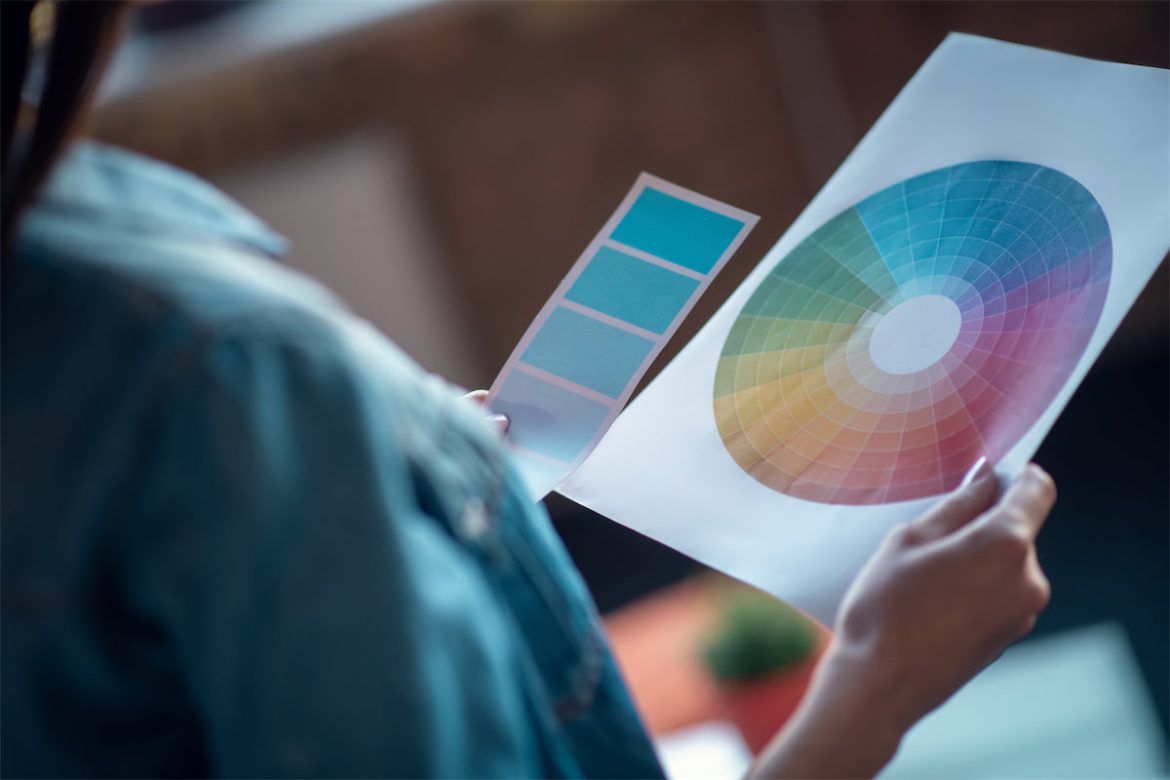
|
Getting your Trinity Audio player ready...
|
When it comes to designing a website, selecting the right color scheme is essential. Color has the power to set the tone of a website, evoke emotion, and ultimately make an impact on visitors. It can also be a major factor in how effectively users interact with and navigate the website.
Picking colors for your website can be challenging. It’s crucial to know how colors affect people and how to use them to convey your brand’s message. Choosing the right colors for a website is important. Colors can affect how people feel. It’s also important to make sure the colors match your brand’s personality and to make the website look good and work well. Experts can help with this.
Before getting into the specifics of how to select the right color scheme, let’s take a look at the psychological impact of color. Color is one of the most powerful tools in a designer’s toolkit, and it can be used to evoke emotion and influence user behavior. Color can be used to create an atmosphere, set the tone, and even influence a user’s opinion. For example, warm colors like red and orange are often associated with energy, excitement, and enthusiasm. Cool colors like blue and green can evoke a sense of trustworthiness and professionalism.
It’s important to identify the core values of your brand when selecting colors. Your color palette should reflect your brand’s values and communicate your message clearly and effectively. Color can be used to create an atmosphere that helps visitors recognize and understand your brand’s message. It’s also important to consider how the colors you choose will appear on different devices and backgrounds. Make sure the colors are legible and easily identifiable on all platforms.
In addition to selecting colors that align with your brand’s values, it’s also important to make sure the colors you choose are aesthetically pleasing. The key to creating a visually appealing website is to ensure the colors are balanced and work together to create an overall harmonious design. However, it’s important to remember that aesthetics should never come at the expense of functionality. Make sure the colors you choose are legible and easy to read, even on small screens.
In the next section, we’ll explore some expert tips and techniques to help you find the perfect color scheme for your website.
Psychological Impact
There is no denying the power of color in web design. Colors have the potential to evoke powerful emotions in your target audience and influence their behavior. When it comes to selecting a color scheme for your website, it is important to understand the psychological impact of the colors you choose.
The relationship between color and emotion is well-established; different colors can trigger different feelings. In particular, colors like blue, green, purple, and yellow have been linked to feelings of peace, relaxation, energy, and happiness, respectively. On the other hand, colors like red, black, and grey have been associated with feelings of danger, anxiety, and gloom. It is important to consider the emotional implications of each color when choosing a color scheme for your website.
Knowing how to effectively use color to evoke certain emotions is critical in web design. Use bright colors like yellow, orange, and pink to create an energetic and lively website. Use cool colors like blue, green and purple to create a calming website.
It is also important to consider how color can influence users’ behavior. For instance, red is often used as an attention-grabber to draw visitors’ eyes to particular content or call-to-actions. Dark colors create urgency and light colors create comfort. Knowing how to effectively use color to influence your visitors’ behaviors is critical in web design.
Overall, the psychological implications of color should be an important factor in your website’s color scheme. It is important to understand how different colors can evoke different emotional responses and influence user behavior before choosing a color scheme for your website. Fortunately, there are a number of powerful color combinations that can help you create a visually appealing and emotionally impactful website.
Aligning with Brand Personality
When it comes to creating the perfect color scheme for your website, it is essential to align your selection with the personality of your brand. Colors are a powerful tool for expressing a brand’s core values and communicating its message to users. Understanding how colors affect behavior is important for conveying your brand’s message on your website to your target audience.
The first step towards achieving the perfect color palette is to identify the core values of your brand. Your color scheme should be designed to reflect your brand’s personality and evoke the right emotions in users. When selecting colors for your website, you should consider the kind of message you want to convey. Is your brand fun and quirky? Is it professional and serious? Consider how the colors you choose will impact the overall feel of your website.
Once you have an understanding of your brand’s personality, you should think of ways to use color to communicate your message effectively. What mood do you want to evoke in users? What kind of impression do you want them to have of your brand? The colors you choose should help you to create a cohesive visual experience that aligns with your brand’s values.
When using color to communicate your brand message, it’s important to be mindful of the potential connotations associated with certain colors. For example, blue is often associated with trustworthiness and reliability, whereas orange is often used to evoke excitement and positivity. Consider how your target audience perceives each color and how this will affect how your brand is perceived.
Your color palette should also be designed to reflect your brand’s personality across all marketing channels. Use colors that you have used in other marketing materials such as print ads, billboard campaigns, and social media posts. Consistency across all marketing channels will help to establish your brand’s identity and create a recognizable visual style.
The right color selection will help to create a powerful and effective visual representation of your brand. Aligning your website’s color scheme with your brand’s personality is essential for creating an effective and memorable online presence. Research the effect of colors on your audience and choose a color palette that communicates your message. Choose colors wisely for website to convey brand message and stand out from competitors.
Aesthetics vs. Functionality
When it comes to website design, it is important to keep both aesthetics and functionality in mind. Aesthetics refer to the visual appearance of the website, including its color scheme, font choices, and overall layout. Functionality refers to the overall usability of the website, from how quickly it loads to how easy it is to navigate.
When selecting a color scheme, it’s important to consider both aesthetics and functionality. Choose a color scheme that matches your brand’s personality and is visually pleasing. Ensure the colors are easy to read and don’t clash with each other. There are several factors to consider when balancing aesthetics and functionality:
First, consider the color contrast. You want to make sure that text and other elements have sufficient contrast with the background color, as this will make them easier to read. Low contrast text is hard to read, which makes visitors leave your site without exploring more.
Second, consider the color palette. Choose a color palette that is pleasing to the eye and harmonizes with your brand’s personality. When selecting colors, try to stick to a few colors that work well together. Too many colors can be overwhelming and can make your website look cluttered.
Third, consider the frequency of colors. You don’t want to overuse any single color, as this can make your website look dull and lack visual interest. Make sure to balance the colors you use throughout the website for a more visually appealing and professional look.
Finally, consider accessibility. It’s important to make sure that your color scheme is accessible to everyone, including those with visual impairments. Choose colors that pass the color contrast test and are compliant with the Web Content Accessibility Guidelines (WCAG).
When it comes to selecting a color scheme for your website, it’s important to consider both aesthetics and functionality. Make your website attractive and easy to use so that visitors enjoy using it and return frequently. With careful consideration, you can create a website that stands out and effectively communicates your brand’s message.
Expert Tips and Techniques
When selecting the right color scheme for your website, it’s essential to consider expert tips and techniques. The right colors can have a powerful impact on your website’s success, so it’s important to take the time to get it right. Keep the following tips in mind when making your decisions.
First, consider the meaning of colors. Different colors can evoke different emotions, feelings, and associations. For example, red can be associated with energy and passion, while blue can be associated with trustworthiness and security. Consider your target audience and use colors that will create the desired impression.
Next, think about contrast. High contrast between colors can make them easier to distinguish, but too much contrast can be overbearing and overwhelming. Consider light and dark colors, as well as text and background colors, to find the right balance.
Third, consider the tone of the colors. Warm colors (red, yellow, and orange) create a bright and energetic atmosphere. Cooler colors (blue and green) bring a calming and serene atmosphere.Choose colors that best reflect the desired atmosphere of your website.
Fourth, take advantage of color tools. There are a variety of online tools and resources available to help you find the perfect color scheme for your website. These tools can provide you with inspiration and ideas, as well as help you compare different color combinations.
Finally, consider design trends. Many websites use similar color schemes, so it’s important to consider the current trends when making your decisions. Study popular websites in your industry and see what colors they’re using. Don’t be afraid to be bold and creative, but be sure to stay up to date with the latest trends.
Create a great color scheme for your website to communicate your brand’s message by using these tips. Take the time to find the right combination of colors and create a website that engages and captivates your target audience.
Conclusion
Selecting the right color scheme for your website is more than just a matter of aesthetics. It is an essential part of creating an effective online presence that reflects your brand’s values and resonates with your target audience. Choosing the right colors is crucial for successful website design. It helps build trust, evoke emotion, and create a visually appealing website.
We have explored the psychological impact of colors, the importance of alignment with your brand’s personality, and the balance between aesthetics and functionality. Identify your brand’s values, choose effective colors, and create a visually appealing website to choose the right color scheme for your website.
Design trends should also be taken into account when selecting a color scheme. Choose colors that represent your brand’s values and appeal to your target audience, while keeping up with design trends. It is also important to remember the importance of testing various color combinations to ensure that they work together and create a cohesive design.
Finally, there are a number of tools and resources available to help you find the perfect color scheme for your website. Use these tools to choose colors that represent your brand’s values and message, and make informed decisions.
In conclusion, selecting the right color scheme for your website is an essential part of creating an effective online presence. Consider color psychology, match your brand’s personality, balance aesthetics and functionality, and use the appropriate tools to make informed design choices and create an engaging website.
